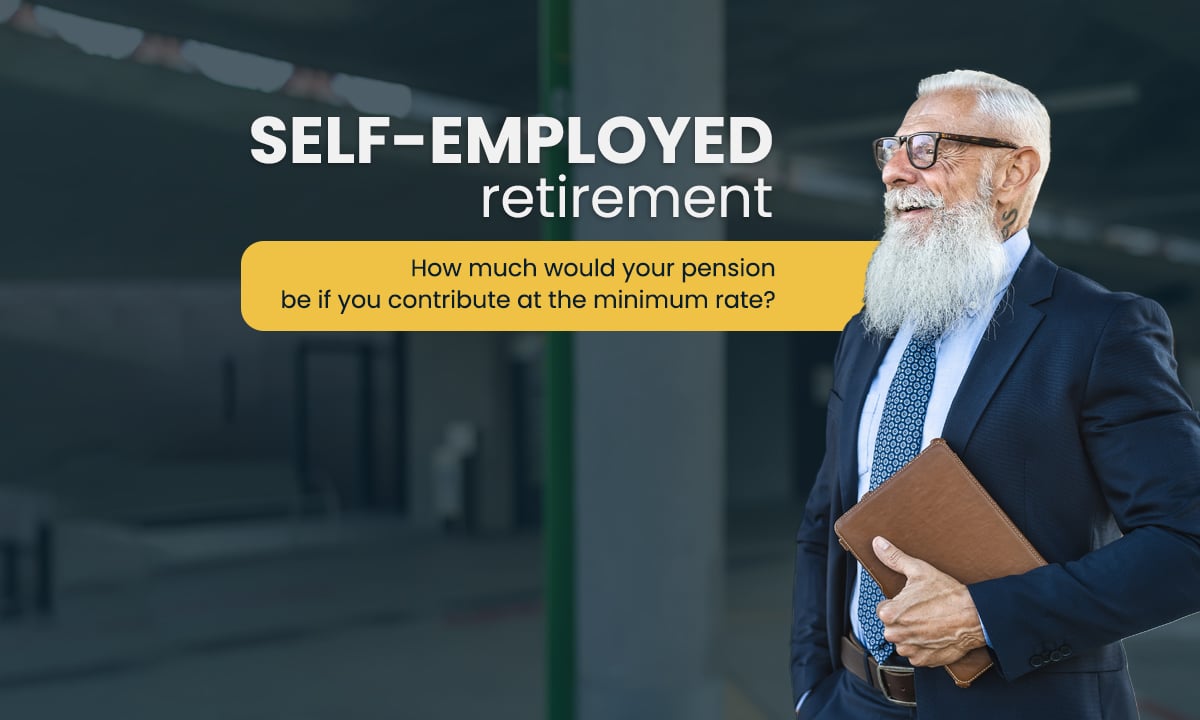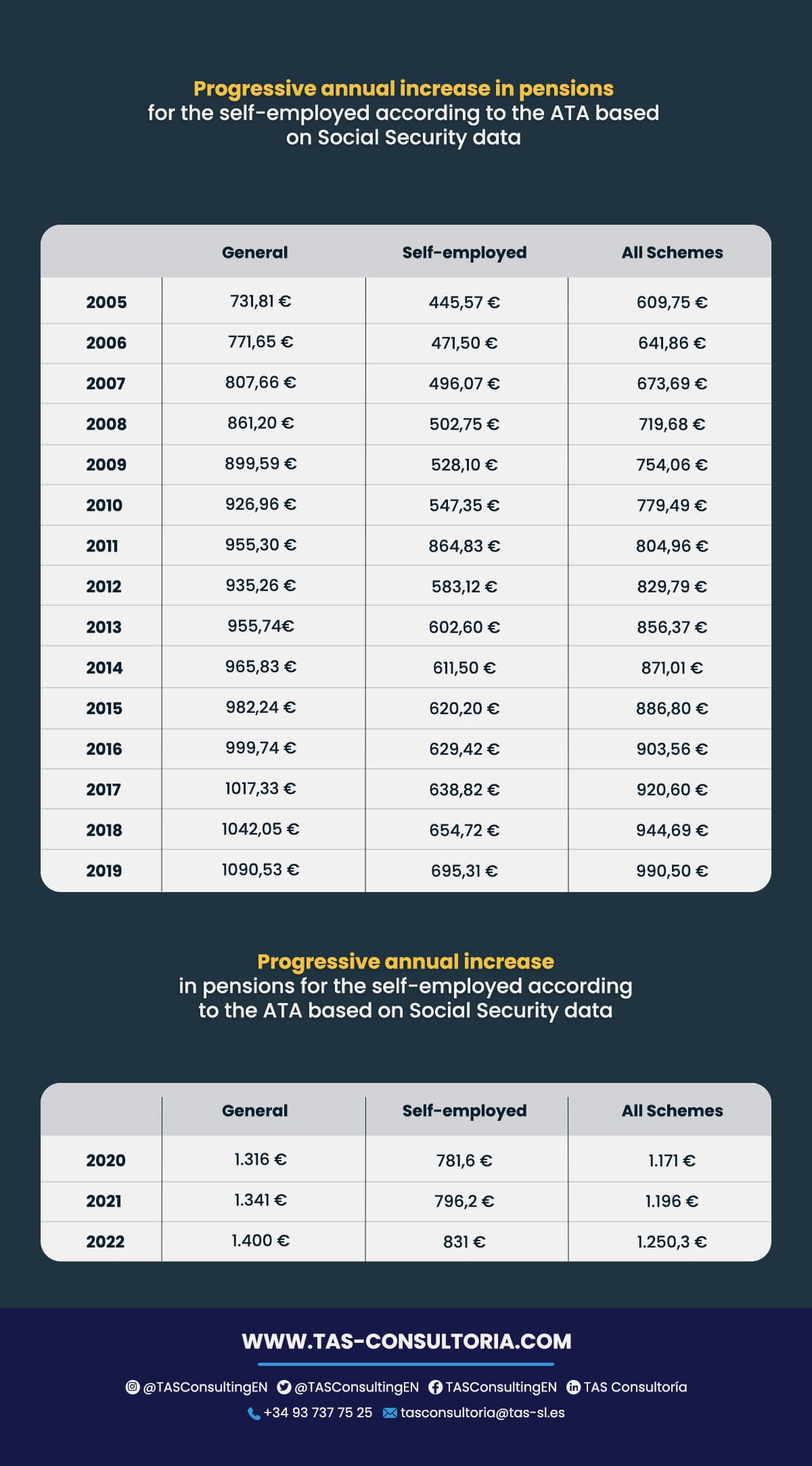Why do the self-employed receive lower pensions than workers with a dependency relationship? In this article we tell you how is the current retirement system for the self-employed and how much is the amount of the pension that is charged, as well as other aspects of great importance, let’s get to it!
The pension of a self-employed person contributing at the average rate
This year, 2022, the self-employed who want to access their retirement and receive the full amount of benefits will have to retire at 65 years of age after 37 years and 6 months of contributions. Now, if the period is less than this, they will have to wait until 66 years and 2 months.
However, even if retirement is accessed, even if the requirements and the appropriate time are met, this does not guarantee that the benefits will be sufficient. This is because, according to Social Security data, as of July 1, 2022, there were already more than 1.9 million self-employed workers receiving an average pension of 750.97 euros per month, which was 444 euros less than the average pension received by workers in the General Regime.
The pensions of the self-employed, in this sense, are much lower than those of employees, with a difference of 37.2%, considering the average amount. The main reason for this is that salaried workers pay the minimum Social Security contribution.
As mentioned by the National Federation of Self-Employed Workers’ Associations (ATA), 9 out of 10 self-employed workers pay the minimum contribution. This means that they pay the lowest contribution to the Social Security, which is currently 294 euros per month. By 2023, this deficiency is expected to be fixed through the new system of quotas for the self-employed, which will allow contributions to be based on actual income.
Now, it is true that these self-employed will be able to save money in the short term, as they will pay a lower contribution, but their pension will suffer significantly, because what many will see may not be worth it.
To help you better understand what we are referring to, we will detail how to calculate the retirement of the self-employed person who pays the minimum contribution in Spain.
The pension of a self-employed person paying the minimum contribution: how to calculate it
Before thinking about how to collect pensions for the self-employed, you should learn how to calculate the self-employed retirement pension.
First of all, the Social Security prepares the calculation considering the 25 years prior to retirement. Thus, in order to get 100%, the retirement age is 65 years and a contribution period of 37 years and 6 months must be credited as mentioned above.
If it is not possible to prove this contribution time, you will have to wait until you reach 66 years and 2 months of age. This applies equally to salaried workers and self-employed workers.
Then, to calculate the amount of the pension, you must add up all the contribution bases for the last 300 months and divide the result by 350.
Currently, the minimum base for the self-employed is 944.40 euros, which, together with the above calculations, results in the pension always being less than 1,000 euros per month.
In this way, the self-employed who have contributed at the minimum rate for 15 years -the minimum required- will receive a pension of 226 euros per month, those who have contributed for 20 years will receive 561 euros per month, while those who have contributed at the minimum rate throughout their working life will be able to access a pension of 789 euros per month.
Now, if you want to increase the amount of your pension, you will have to contribute for a higher base that will allow you to receive better benefits. However, this will force you to pay autonomous contributions of more than 294 euros per month, but you will be grateful for it later.
In this regard, we anticipate that minimum pensions will increase by 3% in 2022, learn more about it:
For children under 65 years of age with a dependent spouse, the amount is 834.90 euros per month and a total of 11,688.60 euros per year.
For those aged 65 or older with a dependent spouse, the amount is €890 per month and a total of €12,467 per year.
For children under 65 years of age with a non-dependent spouse, the amount will be 638.20 euros per month and a total of 8,934.80 euros per year.
For persons 65 years of age or older with a non-dependent spouse, the amount will be 685 euros per month and an annual total of 9,590 euros.
For children under 65 years of age without a spouse, the amount will be 675.20 euros per month and a total of 9,452.80 euros per year}.
Finally, for persons 65 years of age or older without a spouse, the monthly amount will be 721.70 euros, while the annual amount will be 10,103.80 euros.
You may also be interested in: How to become self-employed in Spain if you are a foreigner?
What is the retirement age if you are self-employed: A detailed view
As a self-employed person, you can retire at the same age as a salaried employee. This 2022, those self-employed who want to receive 100% of their pension will be able to retire at the age of 65, as long as they have contributed a period of time of 37 years and 6 months.
As we have already mentioned, if you have contributed less, you will have to wait until you are 66 years and 2 months old to apply for 100% of your pension.
It is important to know that, after the last pension reform was made, the retirement age increases year after year until it reaches, in 2027, the minimum retirement age of 67.
There is also the possibility of collecting part of the pension and continuing to work through active retirement, as long as you meet the requirements.
Now, taking these aspects into account, how many years must a self-employed person contribute to retire? Remember that the amount of money you want to receive as a pension will depend on these years:
The minimum number of years you must contribute in order to retire is 15, with the obligation that 2 of them be within the 15 years prior to retirement. In this case, you would only receive 50% of the regulatory base of your contributory pension.
To get 100% of your pension you must have contributed 37 years and 6 months.
If you contributed more than 15 years and less than 37 years and 6 months, you will be entitled to a lower or higher part of your regulatory base according to the years you contributed.
And, if you contributed less than 15, you are not eligible for a contributory self-employed retirement pension.
You may also be interested in: Is it possible to hire personnel as a freelancer in Spain?
The evolution of the retirement of the self-employed and their pensions: 2012-2022
Specifically, and according to the history of average annual pensions that was published by the National Federation of Self-Employed Workers’ Associations (ATA), while in 2012 these collected 583 euros per month as average pension, in 2020 the amount of the same reached 781 euros per month. And, in 2021, the average pension of the collective was 796 euros until, last March 2022, the pension exceeded 830 euros on average.
As you can see in the table below, each year there is an increase of 20 and 30 euros on the amount of the benefit of the group. As a result, in just 10 years, between 2012 and 2022, self-employed workers have managed to collect an average of 250 euros more per month of benefit.
What’s more, if we compare the benefits provided in 2005, i.e. 17 years ago, with today’s pension, you can see that the new self-employed would retire today receiving 387 euros more per month than before.
Why do self-employed pensions increase monthly?
Experts attribute the increase in the amount of pensions to the fact that a good part of the self-employed have gradually stopped paying contributions at the minimum base in the last decade and have begun to do so at higher bases.
Even so, there are other factors that do not depend so much on the change of base that has been made, but on the process of revaluation of benefits and the increase in the maximum and minimum bases, which are fixed through budgets and which have increased considerably in recent years.
You may also be interested in: Learn about the new quotas for the self-employed 2023-2031
So, here is the question with the retirement of the self-employed and the pension that corresponds to him. If you are self-employed or are part of a company and want to learn more about the business world and the business environment, we invite you to subscribe to our blog and find out everything a good entrepreneur and self-employed should know.






Your email address will not be published .
Required fields are marked with *